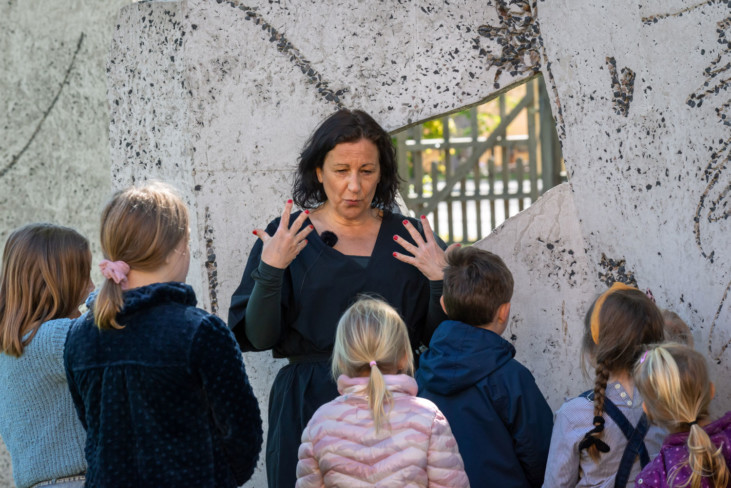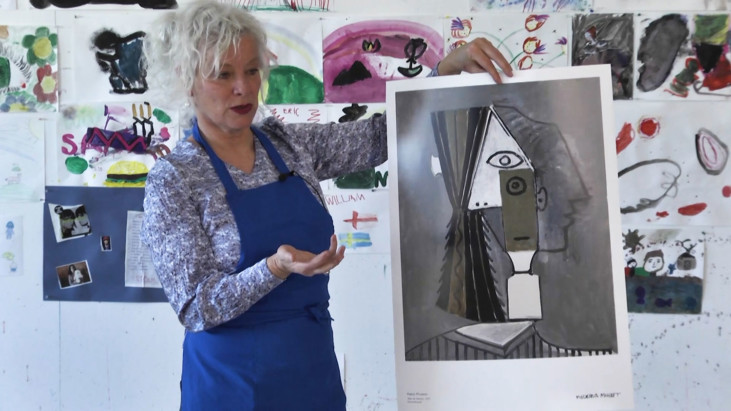
Ingela Ihrman, Passionsblomman (The Passion Flower), 2017 Installation view, Moderna Museet in Stockholm 2018. Photo: Åsa Lundén/Moderna Museet © Ingela Ihrman
8.4 2020
From the archive: Unforgettable performances
Gutai
The exhibition Explosion! Painting as Action opened in the summer of 2012. It featured works by some 50 artists from the 1940s to today. The emphasis was on artists who attacked the fundamental principles of painting in a way that could be both aggressive and playful at the same time. The act of painting and the actual painting itself were equally important, and the work was situated in the borderland between painting and performance.
The exhibition featured the Japanese artist group Gutai, and the weekend of 25—26 August was dedicated to a special performance by its youngest member, Sadaharu Horio, and four colleagues. “Atarimae no koto” (A Matter of Course) is the collective name of Horio’s approach – where the artistic process is as natural as breathing.
Performance weekend Part 1 6:42 min
Performance weekend Part 2 8:24 min
As a teaser for Explosion!, the Museum organised An Experimental Conference to Challenge the Midsummer Sun on 18 June 2011. The title of this conference relates to an exhibition that Gutai held in Japan in 1955, and also celebrates the 50th anniversary of the exhibition Movement in Art, which first opened at the Stedelijk Museum in Amsterdam in 1961, before moving on to Moderna Museet later the same year.
Two classic performance works were staged outside Moderna Museet. One was under the direction of the Swedish artist and art educator Alessandra di Pisa, together with a group of young women who took on Niki de Saint Phalle’s “Shooting Paintings”. The second was a re-performance of “Cannon Shooting Painting” by Shozo Shimamoto, under his direction.
The Swedish artist Anastasia Ax also participated in the conference on 18 June, giving a contemporary framework to the historical context with her performance work PAN THEON.
Shooting Paintings/ Cannon Shooting Painting 5:56 min
Pan Theon 4:22 min
The Studio
The Studio existed on the lower ground floor of the Museum between 2008 and 2011. It was a place for experimental events focusing on young or up-and-coming artists, where they could present performances, sound art, moving images and internet-based works.
The Studio opened on 4 September 2008 with Johannes Nyholm. Two videos document his performance, with Andreas Korsár on the flute. It also features Chapter 2 of Nyholm’s animated everyday drama in four thrilling chapters, The Story of the Little Doll Boy.
Johannes Nyholm and Andreas Korsár 7:04 min
The Story of the Little Doll Boy (Chapter 2) 4:39 min
Night – Eroticism, Beer and Melancholy 3:46 min
On 19–20 May 2010, Ragnar Kjartansson performed non-stop from 8 pm to 8 am at the Studio. In Natten – Erotik, Folköl och Melankoli [Night – Eroticism, Beer and Melancholy], Kjartansson performs Epistle No 72 by Carl Michael Bellman over and over again, stopping only to drink more beer. A 12-hour tribute to the morose, alcohol-steeped eroticism of Stockholm.
Jutta Koether & Kim Gordon
On 4 March 2011, the exhibition The Thirst, featuring Jutta Koether, opened at Moderna Museet. Koether has long been an artists’ artist with her interdisciplinary practice blending painting, performance and music. The exhibition included a performance programme with Jutta Koether, the legendary guitarist Kim Gordon (Sonic Youth) and the sound and image artist/composer Tony Conrad.
At the opening, Kim Gordon appeared with Kim Gordon in the performance work The Thirst, in which they explore a glass wall, reminiscent of the installation in the exhibition. The videos document their performance, which was live-mixed and projected on the walls while it was in progress.
The Thirst Part 1 10:40 min
The Thirst Part 2 12:29 min
Charlotte Engelkes
Under the heading of Performing Art, two performances took place in Moderna Museet’s collection presentation in 2009. On 17 May, Charlotte Engelkes performed Eleven Lovely Lovesongs. “I feel related to Alexander Calder’s circus, his mobiles, his relationship to space, and I’m fascinated by Hilma af Klint’s mediated paintings and receiving of cosmic wisdom. Marcel Duchamp is my music,” is how she describes her piece.
Eleven Lovely Lovesongs Part 1 9:59 min
Eleven Lovely Lovesongs Part 2 8:59 min
The Moderna Exhibition 2018
Since 2006, Moderna Museet has presented an inventory of Swedish contemporary art every four years, the Moderna Exhibition. In 2018, the subtitle was With the Future Behind Us, focusing on the human body – constantly monitored and recorded, squeezed between geographic and legal boundaries, and shaped by ideologies, technologies, power structures and norms – and nature, transformed beyond recognition.
The exhibition included a rich programme of performances. Seven of these are documented in two videos.
The Moderna Exhibition 2018 Part 1 9:25 min
Die Fahne hoch, performed as a waltz, by John Willgren. In connection with the opening on 20 October, Willgren played a Nazi marching song on the accordion outside the Museum entrance. But he had turned the song into a cheerful waltz. It was still the same old song, with the same old message, even in its new version.
The Passion Flower, by Ingela Ihrman. At the opening on 20 October, Ihrman performed the budding, blossoming and pollination of a blue passion flower. When the petals had opened, the audience were invited to drink ‘nectar’ from a flower with straws.
Flyktinglandet [Refugee Land], by Fatima Moallim. Moallim has been engaged in the Flyktinglandet project since 2012, focusing on stories about her parents’ flight from Mogadishu in the 1990s. At the opening on 20 October, she drew a picture on a blank wall, inspired by her own experiences as a refugee, and blending them with the energies of the audience.
The Moderna Exhibition 2018 Part 2 17:15 min
Site Specific for Nowhere, by Dinis Machado. Every Tuesday and Sunday throughout the exhibition period (23 October 2018 – 6 January 2019), Machado would stake out a space in the Museum with his presence and insist on the right to belong there.
Hyphenic, by Tor-Finn Malum Fitje and Thomas Hill. A performance lecture on 10 November, on the boundary between linguistics and biology, identifying the presence of language in common house mould.
Cancamon, by Cara Tolmie. Throughout this work, performed on 10 November, Tolmie used three chosen songs to explore the feeling of the word balm, and how it might be linked to the female singing voice.
Jag är Solen [I am the Sun], by Kalle Brolin. A performance lecture on 10 November, with music by Rainbow Gospel, about the forgotten working-class culture in Scanian coalmines and sugar refineries.
Published 8 April 2020 · Updated 1 March 2024










